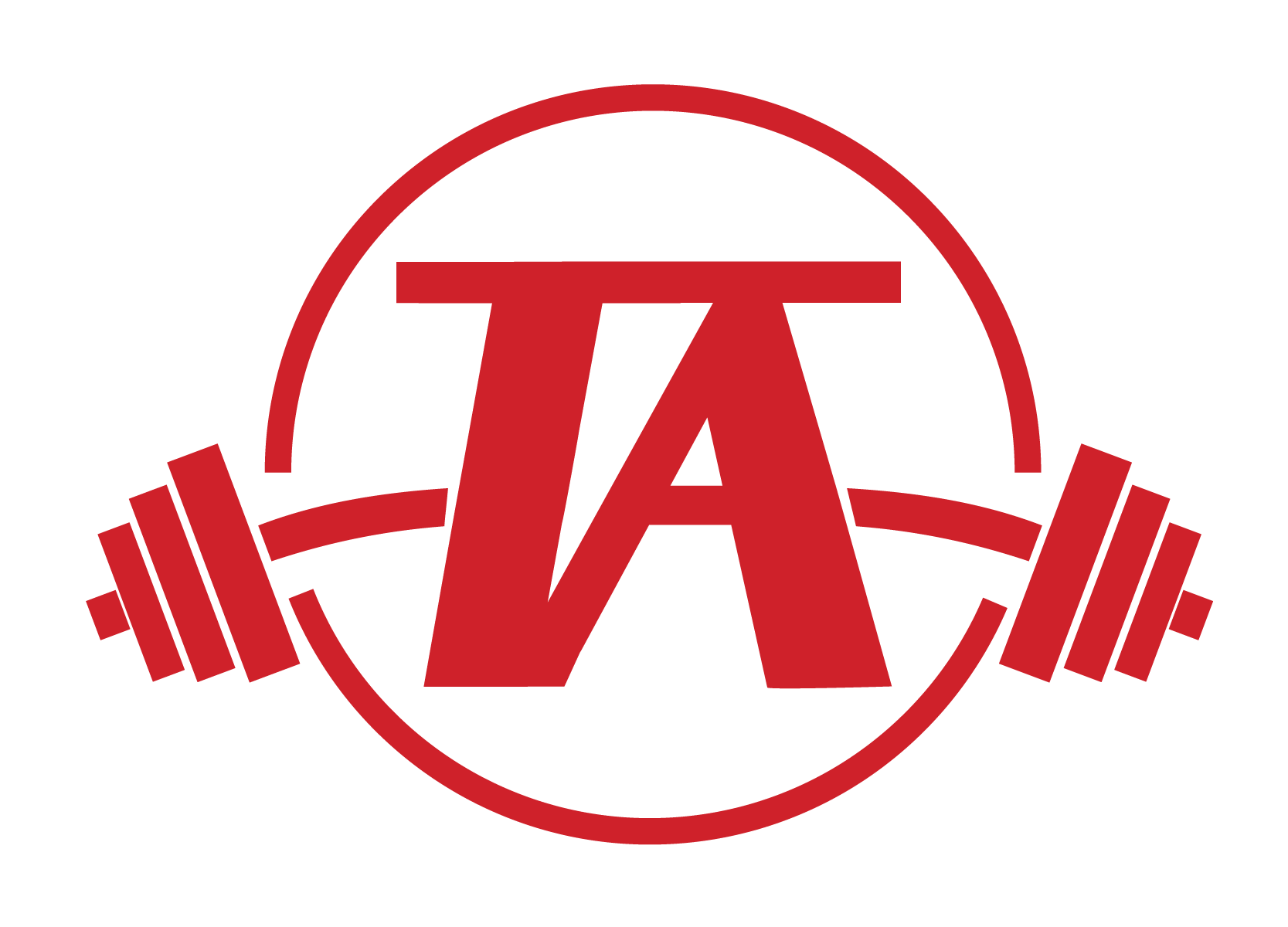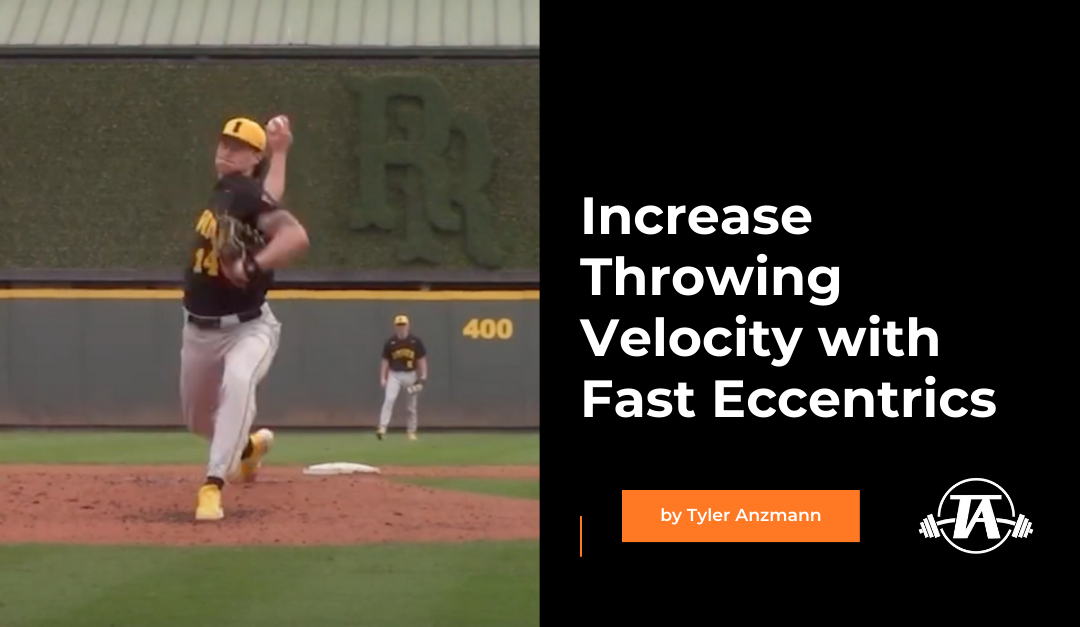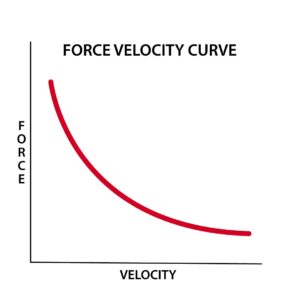In order to maximize your ability to throw a 5oz ball as fast as possible, the ability to use your body like a spring is key. Eccentric training can help athletes do this, but it is often misunderstood. Let’s dive into the research and how we use it with our throwers.
What Is An Eccentric Action?
Muscle actions are typically divided into three types: eccentric, isometric, and concentric. Eccentric muscle actions are lengthening actions. They are the result of force applied to the muscle tendon unit (MTU) that exceeds the force produced by the MTU, leading to a lengthening action during which the muscle continues to produce force. Eccentric actions are often referred to as “negatives” or “negative work” because the muscle is absorbing energy, rather than producing it (Abbott et al., 1952). If we think about this in terms of a bench press and the pecs, during the lowering portion the pecs lengthen (eccentric), at the bottom of the lift there is a brief pause (isometric), before a reversal upwards (concentric). While all of the muscle action types are important, concentric actions tend to get the most attention. In order for athletes to use their bodies like a spring, eccentric and isometric actions are exceptionally important as the eccentric action places a pre stretch on the muscle tissue.
Cal Dietz helped make the importance of eccentric strength much more mainstream with his book Triphasic Training. Oversimplifying his point, Dietz says more powerful athletes have the ability to accept high force more quickly.
What Makes Them Different?
Eccentric actions differ from isometric and concentric actions in a few important ways:
- They are more metabolically efficient (Hody et al., 2019)(Abbott et al., 1952) (Meyer et al., 2003)
- Greater forces can be generated (Hortobagyi and Katch, 1990)
- Herzog et al., suggests that there is a decreased rate of cross-bridge detachment and therefore greater force (Herzog et al., 2008)
- They can be used to absorb shock (Lestayo et al., 2003)
- Store elastic energy and when coupled with a concentric action increase the output (Lestayo et al., 2003)
- Often produce more intense delayed onset muscle soreness (DOMS) (Hody et al., 2019)
Benefits
The benefits of eccentric training are not all fully fleshed-out, but there are many likely benefits that have a fair amount of research behind them.
- Greater increase in strength relative to concentric training (Hody et al., 2019)
- Greater increase in muscle size relative to concentric training (Hortobagyi et al., 1996)
- Greater recruitment of high threshold motor units (Nardone and Schiepatti, 1989)
- Shift in length tension relationship to longer muscle lengths (Brughelli and Cronin, 2007)
- May increase contractile speed of muscle fibers (Goldspink, 1985)
- May preferably hypertrophy type II fibers (Douglas et al., 2017)
- May increase number of sarcomeres in series (Lynn and Morgan, 1985)
- May increase fascicle length (Duclay et al., 2009)
- May improve the ability to activate agonists (Aagaard, 2003)
- Potential for decreased agonist inhibition from Golgi tendon organs (Aagaard, 2003)
These benefits have significant implications for improving throwing velocity that we’ll discuss shortly.
Slow vs Fast Eccentrics
Eccentric training, especially in a traditional sense, tends to mean slow tempo, however, to derive the greatest throwing related performance benefits, high velocity eccentric training is the ticket.
Slower tempo eccentric training has benefits as well, such as helping to teach beginner trainees new movements, having an analgesic and healing effect for athletes with tendinopathy (which is more related to the tempo than muscle action type), and increasing time under tension for hypertrophic purposes. For more advanced athletes, however, high velocity eccentrics can have a significant impact on performance.
A typical force velocity curve is viewed in the context of concentric muscle actions. This curve shows that as velocity increases, force decreases. Eccentric actions are not subject to these same rules. As the velocity of eccentric actions increase, so does force.
How Does This Relate to Throwing Velocity?
As discussed in the introduction, in order to maximize throwing velocity we need to be able to use our body like a spring. This is where eccentric actions and eccentric training come into play.
Let’s start with eccentric actions themselves. As an eccentric action occurs the elastic tissues (muscle, tendon, fascia) are stretched, which means they store elastic energy that can be utilized as the tissue returns to its starting length. The faster an eccentric action can occur, the higher the output will be (provided that an athlete is strong enough eccentrically to control this movement). We can see great examples of this when it comes to vertical jump research. Researchers found that the faster the descent (eccentric) velocity, the higher the jump height (Badillo and Marques, 2010).
In order to improve the ability of an athlete to withstand high eccentric velocity, the stiffness of the “springs” must be increased. The “springs”, or muscles, tendons, and fascia, exist on a continuum of compliant to stiff, with greater stiffness being associated with higher velocity performances. This makes sense as a compliant, or stretchy, tendon will take longer to pull on the skeleton than a stiff tendon will when a muscle action occurs.
Stiffness can be enhanced through both heavy strength training and high velocity movements. Greater stiffness means that energy can be more efficiently transferred between body segments. In a complex movement such as throwing, this means that energy can more effectively build like a wave. The less energy that is lost as heat throughout the process, the higher the ultimate output will be.
For example, as the arm is flipped up heading into foot strike, the pec will lengthen (eccentric) quickly, prior to “catching” or reaching end range, when the stretch shortening cycle will engage and reflexively pull the arm through to ball release. If this is timed properly, the force and velocity of this reflexive action will be higher than what can be accomplished volitionally. However, if the tissue around the shoulder complex is not stiff enough, some of this energy will be lost as heat and the arm will not be accelerated as effectively.
In terms of adaptations that occur as a result of fast eccentrics, let’s discuss a few.
Fascicle Length
Increased fascicle length is important as it is associated with faster contraction velocities. Longer fascicles mean a greater number of sarcomeres (the smallest functional unit of muscle tissue) in series and all of these sarcomeres shorten at the same time. If a greater number of sarcomeres in series shorten at the same velocity, a greater distance has been covered in the same amount of time. This equates to higher shortening velocity.
It has been shown that faster 100m sprinters have longer fascicles than their slower counterparts (Kumagai et al., 2000). This can be applied to throwers as well.
Fiber Type Shifts
There are two broad categories of muscle fibers: fast twitch and slow twitch. Beyond this basic level of familiarity, there is more that can be gleaned from understanding some important differences between the fiber types and subtypes.
Within the fast twitch (type 2) muscle fibers there are two important subcategories: type 2a and type 2x. Type 2x fibers have the fastest shortening velocities (~5-6 fiber lengths/second), while type 2a are still very fast (~3-4 fiber lengths/second) but are a bit slower than type 2x (Beardsley, 2021), and both types are significantly faster than type 1 fibers (0.5-1.0 fiber lengths/second) (Beardsley, 2021).
Depending on the type of training performed, fibers can shift their type from 2a to 2x, and vice versa. The more fatigue that is present in a training program, the more likely a shift is to occur from type 2x to type 2a. This may or may not be a problem depending on the force-velocity profile of the athlete, but as strength standards and basic body composition requirements are met, this is worth keeping in mind when programming. Type 2a can shift to 2x provided that the velocity is high enough and volume is relatively low.
This is just one reason why distance running and high volume, low to moderate intensity training programs tend to be incompatible with a goal of maximizing throwing velocity. If you want to maximize throwing velocity, high intent and low fatigue during training sessions are musts.
Stiffness Changes
Muscles and adaptations related to them are incredibly important when it comes to maximizing throwing velocity, but there are limitations to a purely muscle-focused approach. Concentric muscle actions are limited in that as the shortening velocity increases, force decreases—so at very high shortening velocities, very little force is produced. At the highest movement velocities, it may not even be possible for muscles to shorten fast enough to help in a meaningful way, as peak concentric force can take well over a second to produce (much slower than most athletic movements). This is why elastic energy storage and release is so important in high velocity movements, including throwing. Tendons play a large role here. They can be thought of as amplifiers to our muscle power. When tendons are stretched, they store elastic energy to be released later, producing output much greater than muscles alone are capable of.
In order to increase the amount of force that is transferred from a muscular contraction and increase the amount of elastic energy that can be stored and released, tendon stiffness often must be improved. Stiffer tendons require more force to be stretched, but they return more elastic energy. Compliant tendons, on the other hand, change length without requiring as much force to be exerted on them. Think about trying to pull a heavy stone using a very stretchy rubber band; this would be like a very compliant tendon in that force transfer (greatly inhibited). Next, think about pulling that same heavy stone with a chain; this would be like a stiffer tendon in that force transmission (better and more immediate).
Research has shown that elite 100m sprinters have stiffer Achilles tendons and stronger calves to go along with those stiffer tendons (Arampatzis et al., 2006). Stiffer tendons require stronger muscles in order to stretch them, so this makes sense. Similar adaptations occur at the shoulder and arm in overhead throwers. These adaptations occur as a result of high velocity training and also help to increase their technical proficiency.
How Should This Be Integrated?
Prior to integrating fast eccentric training into an athlete’s training program (in order to maximally benefit) an athlete should be able to hold end range type positions during yielding isometrics for at least 30 seconds. Fast eccentric training can be a great addition to training programs if it is integrated properly. As with all other forms of training, progressive overload is key, don’t just jump into the most intense variation of training possible.
We’ll often begin with eccentrics, not connected to a concentric movement-meaning an athlete will drop and stick. Some examples would be:
Altitude Landings
Drop-Catch Push-Ups
Some coaching points for each of these:
- Accelerate as fast as possible to the bottom of the movement
- Stop abruptly
- Height should be selected to overload the athlete, this can be done by choosing a drop height higher than their maximal vertical jump or ballistic push-up.
Volume should be kept low at the beginning, especially within sets, as we’re looking for intensity and quality over volume. Frequency will generally be no more than 2x/week for a given body part.
The next option is often band resisted movements as they can help accelerate the eccentric portion of the movement. Other options are also available under this umbrella of accentuated eccentrics, such as weight releasers and manual resistance, but bands are most likely to be available and easiest to set up. Simple is generally better when selecting movements here as the focus should be on output rather than complexity of execution. Squats and presses both work well, just to name a few.
Coaching Points:
- Move as fast as you can to the bottom of the movement
- Minimize the delay between the eccentric and concentric-think about bouncing
- Move as fast as you can toward the top-the band resistance at the top will allow you to accelerate a bit longer than standard, non-ballistic movements
- Choose loads that allow high velocity-generally we won’t go above 80% 1RM at the high end
The most intense option is shock training. Shock training involves added kinetic energy (from falling from a given height) and use of the stretch shortening cycle. This method will utilize the lowest volumes and frequency of any of the methods discussed as the intensity is the highest.
A few options we’ve used:
Depth Jump (classic)
Shock Push-Up
Partner Drop Med Ball Chest Pass
Conclusion
Eccentric training isn’t just slow tempo training used in the first phase of Triphasic Training, it can be so much more than that and provide significant benefits. If you want to maximize the physical attributes required to throw at your maximal velocity, fast eccentrics are a valuable tool in your toolbox as you continue your Stay tuned for Part 2 where we’ll take a deeper dive into how to implement these into a holistic program, including during a competitive period.
Looking for some guidance in your development? Train with us remotely or in person and let’s get you on track! Contact us here!


